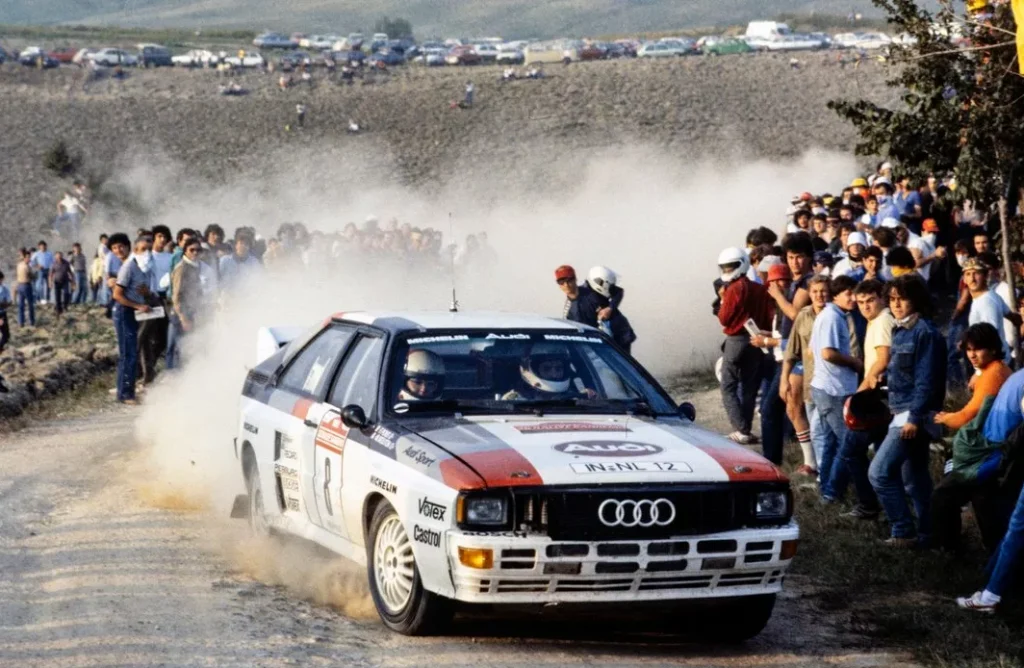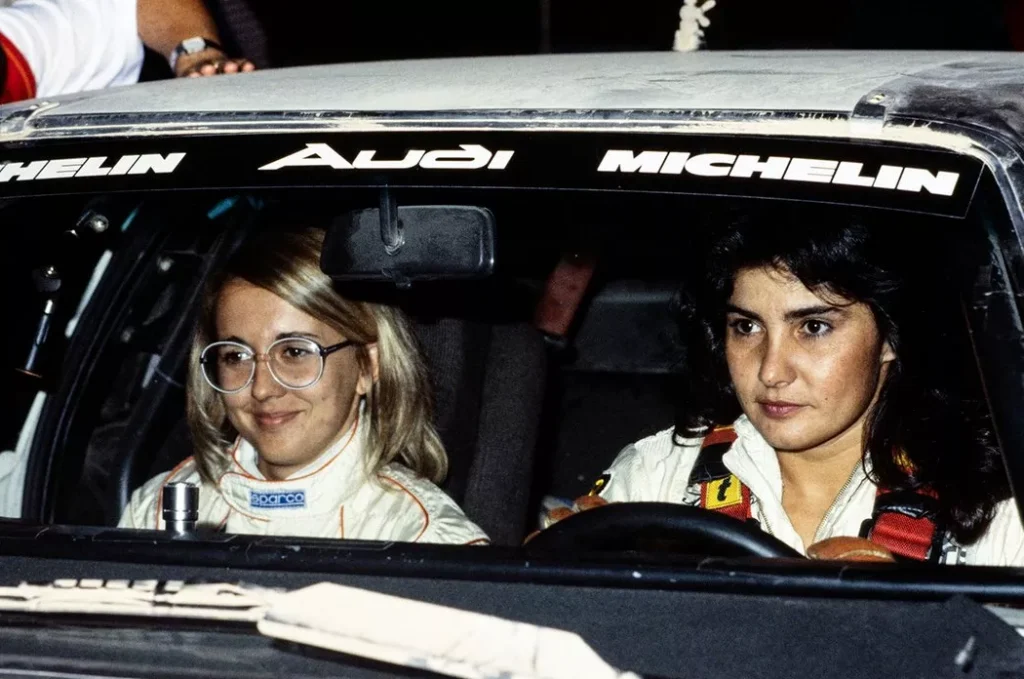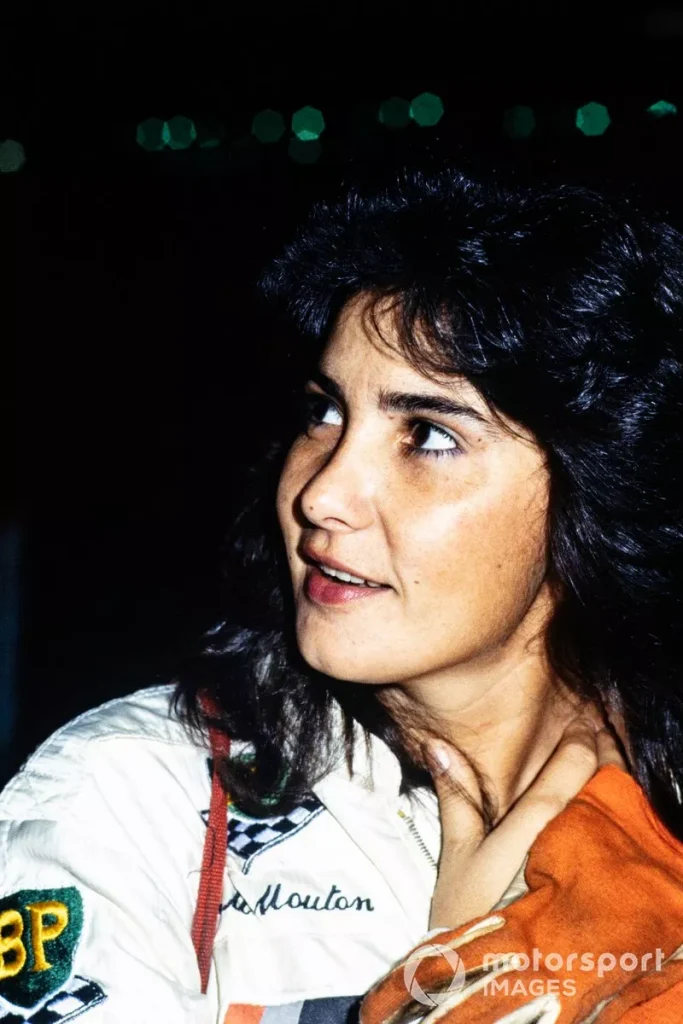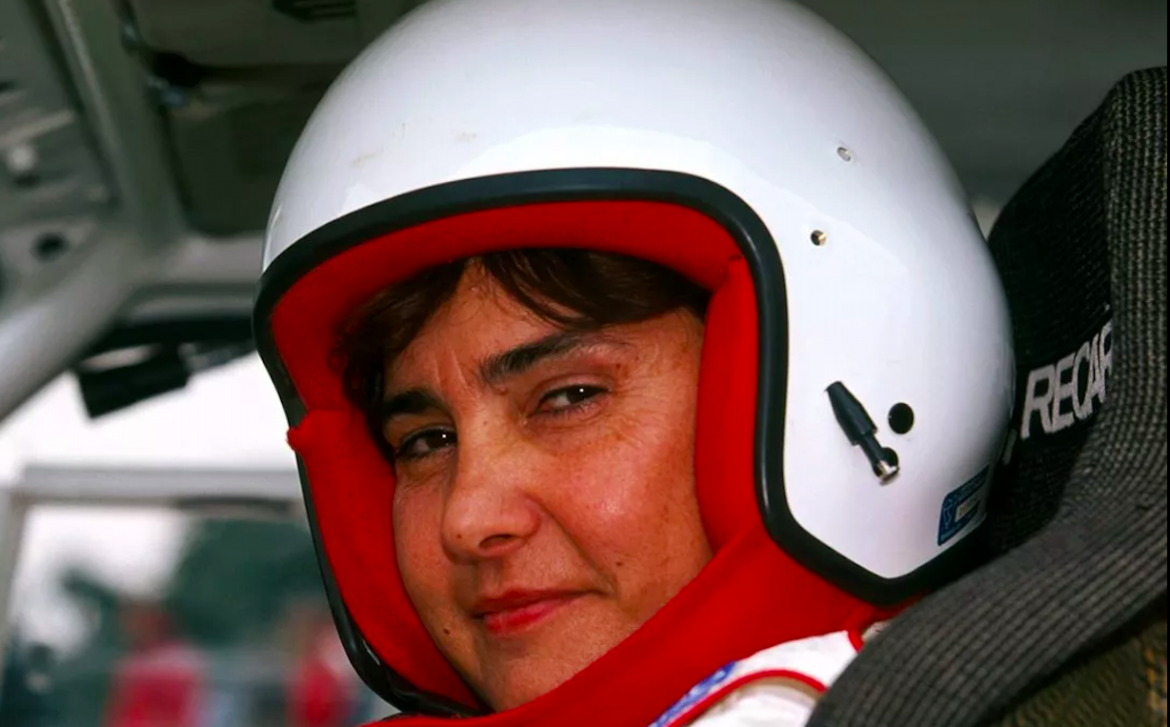“Some people drive because they want to be famous, some just because they love it, and some want to prove something to themselves. I never cared what anyone else thought. I wanted to prove to myself that I could do it.”
– Michèle Mouton
Born in Grasse, the French capital of perfumery, Michèle Mouton’s life is best recollected amidst the scents of burning rubber, engine oil, and exhaust fumes rather than the delicate notes of jasmines and roses cultivated by her parents. Despite showing no early inclination towards motorsport, Mouton’s trajectory shifted when her friend Jean Taibi invited her to practise the 1972 Tour De Corse with him and later co-drive for the Monte Carlo Rally in the inaugural year of the World Rally Championship (WRC).
Her initial driving experience was confined to her father’s Citroen 2CV, yet rallying’s undeniable allure prompted her and her father, a racing enthusiast himself, to nudge Mouton into the driver’s seat. He provided her with an Alpine A110 and the necessary funding to test her mettle, setting the stage for her rally journey.
Mouton made her debut at the 1973 Rallye Paris, followed by participation in the Tour de France Automobile, where her commendable 8th overall position in a supplementary event to the Tour De Corse contributed significantly to Alpine-Renault’s manufacturer’s championship victory in 1973. Her consistent performance in 1974 and 1975 culminated in her winning the Ladies French-European championship both years.
What a remarkable feat for a woman, right? Well, not for Mouton.

In 1975, Mouton grasped the opportunity to compete in the 24 Hours of Le Mans as part of an all-women’s team driving a Monyet Prototype. Her rally expertise proved beneficial as she adeptly navigated challenging conditions, securing first place in their category and a commendable 21st position overall.
Reflecting on the experience, Mouton expressed her sheer glee, recalling, “I remember it began to rain, I had a lot of fun out there! My pit crew told me to stop, but I carried on and passed even some of the big cars! The conditions suited me to a tee. In fact, it was as if I were rallying at Le Mans. I just relied on my rallying skills and experience. The night didn’t bother me either as I even did some long stints. The race was a completely new environment for me and extremely interesting.”
From 1977 to 1979, Mouton achieved numerous podium victories across different cars, including the Fiat 131 Abarth, Porsche Carrera RS, and Lancia Stratos. However, a groundbreaking opportunity awaited her in 1980 when she joined the newly formed Audi Sport team. This marked a pivotal moment as she piloted their innovative Quattro, the inaugural turbocharged and all-wheel-drive rally car that would later dominate the rally circuit.
Audi’s decision to feature a woman on their team, especially over several male drivers, was met with scepticism by many. Undeterred, Mouton expressed that she felt she had nothing to prove, desiring only to be on par with her male counterparts. In response to Michèle Mouton’s presence in the WRC, the 1981 championship winner, Ari Vatanen, was quoted as saying, “The day I will be beaten by a woman, I will stop racing.”
Mouton’s competitive season with Audi in the WRC didn’t commence until 1981 when she achieved a historic victory at the San Remo Rally. This triumph marked the first time a woman had ever won a round of the WRC, establishing a significant milestone for both her and her new female co-driver, and later longtime friend, Fabrizia Pons.

Despite mechanical failures affecting her performance for the remainder of the 1981 season, Mouton bounced back in 1982, claiming victories in Portugal, Greece, and Brazil. These victories positioned Mouton as a serious contender, challenging the perception of her by other drivers.
Would you like to guess who came in second in that round? Ari Vatanen. And if you’re wondering how he took his early retirement, it was with a tablespoon of hypocrisy and denial. Contrary to his bold and boisterous statement, Vatanen did not retire.
In virtually every superhero universe, a prevailing theme unfolds: the antagonist, driven to disrupt the prevailing status quo, introduces transformative elements to the established order. The superhero, in response, embarks on a mission to counter these disruptions and restore a utopian balance. However, this stark contrast between heroes and villains in fictional realms diverges significantly from the nuanced dynamics of our reality.
In the real world, change is imperative, heroic even, and the process often entails some collateral damage. Mouton’s foray into the testosterone-fueled realm of motorsport, inevitably challenged the status quo, stirring controversy and ruffling one too many feathers. As is the fate of changemakers, Mouton too had to overcome the due resistance, vilification and gendered bias in the wake of her trailblazing career.

The decision to select her for the Audi team instead of an established male rival generated considerable publicity and speculation, with some suggesting that Audi’s choice stemmed from the novelty of hiring a female driver. Here’s another- the ‘legendary’ rally driver Walter Röhrl had publicly discounted Mouton, caustically stating that one could put a monkey in the Audi and it would win. Maybe he was right but Mouton was also beating her Audi teammate at the time, Hannu Mikkola, who was no monkey and no slouch as WRC champion in 1983 and who was driving identical machinery.
The Group B era, which began in 1983, emerged as the most iconic chapter in WRC history. Relaxed homologation rules ushered in unprecedented levels of horsepower, exceeding 400, and unparalleled speeds. Finnish rally driver Juha Kankkunen remarked, “WRC is for boys – but Group B was for men”. Well, Kankkunen clearly did not anticipate the storm that was about to hit the boys, eh, men’s club – Michèle Mouton.
Not all storms are granted the privilege of names; this distinction is reserved exclusively for a select few—tropical storms and hurricanes—demanding humanisation for the sake of comprehension. Michèle Mouton, starting from 1983, underwent a similar process of nomenclature, earning various monikers like “the devil with the face of an angel,” “the gentle savage,” and “the black volcano” bestowed upon her by the media.
If you think about it, these oxymoronic names are very telling of the times when there was no established vocabulary to talk about women navigating the male-dominated world of motorsport—a domain where their presence was considered an anomaly. Just as a hurricane disrupts the ordinary course of nature, Michèle, with each epithet and achievement, disrupted and reshaped the preconceived notions within the traditionally male-centric sport.
In 1984, Audi brought Michèle Mouton and the Quattro to Pikes Peak Hillclimb, where she claimed the first position in her class. The following year, in 1985, she achieved the overall victory, surpassing the previous record set by Al Unser Jr., the nephew of the legendary ten-time Pikes Peak winner Bobby Unser. Bobby Unser was most positively discontent at his nephew being defeated by both a European car and more so by a woman, offering some pointed remarks. In response, Mouton retorted, “If you have the balls, you can try to race me back down as well.“

During its brief four-year existence, Group B is renowned as one of the wildest, most perilous, and chaotic chapters in motorsport history, marked by tragic fatalities among both drivers and spectators. The regulations governing car construction in Group B were remarkably lax, allowing manufacturers to employ any materials and generate unrestricted power. This resulted in some unbelievably fast cars even by contemporary standards.
After 4 seasons and the tragic deaths of 4 drivers and 3 spectators, Group B concluded in 1987. And with Group B, Michèle Mouton retired from racing to start a family. But that did not stop her from continuing to be an active part of the motorsport scene. Mouton was engaged in numerous exhibition events over the next two decades. In 2010, she assumed the role of the first president of the FIA Women & Motorsport, aiming to break all and any gender barriers.
In a documentary dedicated to her titled “The Queen of Speed “, the formidable, high-speed, and often perilous Group B era of rallying in the early ’80s comes alive to testify to Mouton’s marvellous career. The documentary reiterates that despite unfounded insinuations of her selection being based on intimate connections, allegations of tampered engines, and the subsequent debunking of these claims, Mouton remained thoroughly undeterred in her resolve.
What’s quite remarkable is that her motivation was never rooted in a pursuit of fame or a desire to be the best. As she succinctly put it, “I never needed, or wanted, or thought I had to justify myself in anything. I did all that for myself. Not to be the only woman in their world. What has always been important was to prove to myself that I was able to do it and to reach their level but it was for me, not for them. I just wanted to do the same, that’s all.”
From the inception of her motorsports career, Michèle Mouton was steadfast in her stance that she didn’t wish to be perceived as a “fast woman driver” but solely as a “fast driver.” She became exactly that — one of the fastest drivers of all time.



